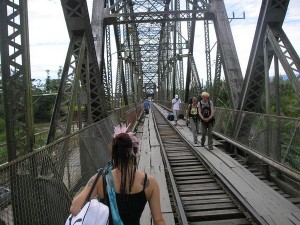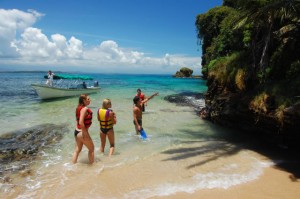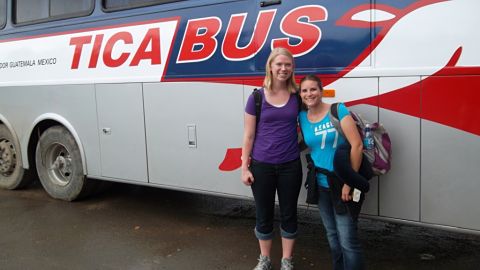Costa Rica English Teaching News – Visa runs are a necessary part of life as an English teacher in Costa Rica. In part I of this series I discussed some of the options available in Costa Rica’s northern neighbor, Nicaragua. In part II, I discuss the other common destination for English teachers to take their mandatory vacation every 90 days: Panama. Part of the fun of a trip to Panama is the actual trip itself. Unlike Nicaragua, where Costa Rican bus company Tica Bus provides both comfort and ease in terms of getting to and across the border, no such service is available for the journey south. The only exception would be if you’ve decided to venture all the way down to Panama City – but more on that later.
Part of the fun of a trip to Panama is the actual trip itself. Unlike Nicaragua, where Costa Rican bus company Tica Bus provides both comfort and ease in terms of getting to and across the border, no such service is available for the journey south. The only exception would be if you’ve decided to venture all the way down to Panama City – but more on that later.
There are a couple border crossings to choose from but the two most popular are the crossings near Golfito on Costa Rica’s Pacific side and at Sixaola, on its Caribbean coast. Sixaola, based on its proximity to tourist haven Bocas del Toro, is by far the most visited.
Calling Sixaola a town is an extremely generous exaggeration. The pueblo – quite literally – has a convenience store, a liquor store and an information booth that they call immigration. The local bus will take you right to where the border crossing is located. Once off the bus, walk up the hill immediately in front of you and get in line to get your passport stamped out of Costa Rica. After this you will – and get ready – walk across a bridge, which looks like it can’t hold an ant, over to Panama. Do watch your step as to not mistakenly plant down on a loose board.
When you arrive on the other side of the bridge, get in line once again to get stamped into Panama. At this point you can either continue on your journey by local bus or take up the services of one of the local taxis that will be waiting for you. If you have a group of people, or made friends during your bridge crossing, the taxis are actually quite inexpensive.
The most common and popular destination in Panama to fulfill your visa run obligation is Bocas del Toro. If you’re not familiar with this group of islands on Panama’s Caribbean coast, I highly recommend researching them as they truly are one of the great natural wonders in Central America. If you’re coming from San Jose, as most English teachers do, the trip to Bocas has two options. You can either head there from San Jose in one day, which would take about eight or nine hours depending on border traffic. The other option is to break up the trip by spending a night in Puerto Viejo, a popular and beautiful beach town on Costa Rica’s Caribbean coast situated about an hour by bus from the Panama border.
Whichever option you choose, once in Bocas you will marvel at its beauty. Bocas is a mix of a myriad of tropical islands, of which two realistically provide viable stay options. The main island, Colon, has numerous hotels and hostels at the disposal of its visitors. Colon is also home to most of the restaurants and nightlife spots in Bocas. If you like to party, you might consider this as your main hub.
If you seek a more tranquil experience, Isla Bastimentos is for you. The biggest island in Bocas, it is almost all jungle covered. The few hostels that do exist offer a very quiet and distanced experience. The island is great for hiking,  exploring and is home to one of the more popular beaches in all of Bocas, Red Frog Beach, where, just as its name suggests, you can see rare red frogs.
exploring and is home to one of the more popular beaches in all of Bocas, Red Frog Beach, where, just as its name suggests, you can see rare red frogs.
Tours of all variations are plentiful in Bocas and for reasonable prices. One of the more expensive – maybe $20 per person – but also most worthwhile is the boat tour to Isla Zapatillas. Home to nothing but nature, you will be alone on a pristine island for the day with soft white sand, beautiful views and nothing but what you bring with you. This trip is a must.
While Bocas del Toro is by far the most common visa run destination in Panama, there are other options. Panama City is beautiful and gives a ‘big city’ feel not often found in Central America. If you can stomach the 16 hour bus ride – one way – from San Jose (or the alternative roughly $300 round-trip flight) it is definitely worth checking out. Panama City is also great for those who like shopping, as Panama is much cheaper than Costa Rica in general and Panama City has some great stores and even cheaper rates than other places in the country.
David is another great option for a quick visa run. Located on the western half of Panama, a crossing from Golfito is more recommended for this trip. The third largest city in Panama, it is only 30 kilometers from the border with Costa Rica enhancing convenience. While a nice place to visit to get a feel for ‘real Panama’ – as David is not as touristy as other places – there is not a lot to do. Nearby locations such as Boquete – including its famous hot springs Los Pozos de Caldera – and Playa Barqueta offer great attractions on your trip.
While just a sampling of things to do in both Nicaragua and Panama on your visa runs, the idea is that you are not limited to what you can do. The often maligned part of teaching English in Costa Rica can also be the most exciting. Both countries offer extensive possibilities and part of the adventure is finding them on your own.
If you want more information about teaching English in Costa Rica or getting your TEFL or TESOL certificate in Costa Rica feel free to contact Andrew at the Global TESOL College or email [email protected]
Originally from Toronto, Canada, Woodbury is the academic director of Global TESOL College Costa Rica , a contributor to radio program This Week in Costa Rica (http://thisweekincostarica.com/), and an independent writer based in Costa Rica.

